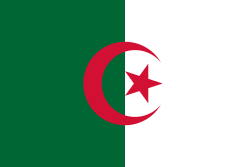 The flag of Algeria | |
| Data | |
|---|---|
| Water coverage (broad definition) | (improved water source): 84% (2010) (JMP) [1] |
| Sanitation coverage (broad definition) | (improved sanitation): 95% (2010) (JMP) [1] |
| Continuity of supply | 22 (2013) [2] |
| Average urban water use (L/person/day) | 65–220 depending on the province [3] |
| Average urban water and sanitation tariff (US$/m3) | 0.08 (residential 1st consumption block, 2005) [4] |
| Share of household metering | high |
| Annual investment in WSS | 4 billion USD (2010–2014 average including dams and irrigation) [5] |
| Share of external financing | Mainly by the state |
| Institutions | |
| Decentralization to municipalities | No |
| National water and sanitation company | AdE (drinking water) and ONA (sanitation) |
| Water and sanitation regulator | None |
| Responsibility for policy setting | Ministry of Water Resources |
| Sector law | Loi 05-12 of August 4, 2005 |
| No. of urban service providers | 2 (AdE for drinking water and ONA for sanitation) |
Drinking water supply and sanitation in Algeria is characterized by achievements and challenges. Among the achievements is a substantial increase in the amount of drinking water supplied from reservoirs, long-distance water transfers and desalination at a low price to consumers, thanks to the country's substantial oil and gas revenues. These measures increased per capita water supply despite a rapidly increasing population. Another achievement is the transition from intermittent to continuous water supply in the capital Algiers in 2011, along with considerable improvements in wastewater treatment resulting in better water quality at beaches. These achievements were made possible through a public-private partnership with a private French water company. [6] The number of wastewater treatment plants throughout the country increased rapidly from only 18 in 2000 to 113 in 2011, with 96 more under construction. [7] However, there are also many challenges. One of them is poor service quality in many cities outside Algiers with 78% of urban residents suffering from intermittent water supply. [2] Another challenge is the pollution of water resources. There has also been insufficient progress concerning reuse of treated water, a government priority in this dry country.
Contents
- Access
- Service quality
- Water resources and infrastructure
- Conventional water resources
- Non-conventional water resources
- Infrastructure
- Water use
- Responsibility for water supply and sanitation
- Policy and regulation
- Service provision
- Financial aspects
- Investment and financing
- Tariffs and cost recovery
- External cooperation
- References
- External links





